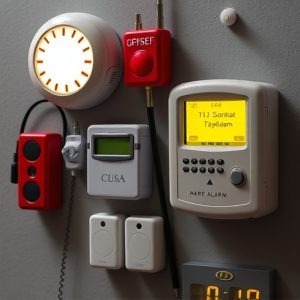Personal Distress Signals with Tracking: A Comprehensive Comparison
Personal distress signals with tracking features, particularly those utilizing GPS and cellular netw…….
Personal distress signals with tracking features, particularly those utilizing GPS and cellular networks, are invaluable for emergency situations. The Personal Alarm Distance Range Comparison is critical, typically ranging from 30 to 200 meters, influencing protection levels in diverse environments. Advanced alarms offer extended ranges, ideal for outdoor activities or remote areas where communication is limited. When selecting a personal alarm, consider usage scenarios (urban/remote), environments (indoor/outdoor), and frequency of use to ensure optimal tracking range alignment with individual needs while addressing privacy concerns related to their tracking capabilities.
Personal distress signals with tracking capabilities have emerged as powerful tools for safety and peace of mind. Understanding these signals, or personal alarms, involves grasping their basic functions and recognizing the distress they’re designed to convey. This article delves into the technology behind these devices, explores distance ranges in a Personal Alarm Distance Range Comparison, examines real-world applications, and addresses ethical considerations and privacy concerns.
- Understanding Personal Distress Signals: The Basics
- Tracking Technology: How It Works and Its Benefits
- Comparing Distance Ranges: What to Consider
- Real-World Applications: When and Why to Use Them
- Ethical Considerations and Privacy Concerns
Understanding Personal Distress Signals: The Basics
Personal distress signals are vital indicators designed to alert others when an individual is in danger or needs immediate assistance. These signals can take various forms, from verbal pleas for help to physical gestures or the use of specialized devices. Understanding and recognizing these distress signals early on can significantly impact response times during emergencies.
When it comes to personal alarm devices with tracking capabilities, one key consideration is the distance range they cover. A Personal Alarm Distance Range Comparison reveals that these devices vary in their effective reach, typically ranging from 30 to 200 meters (98–656 feet). Understanding this range is crucial as it dictates the level of protection offered and helps individuals assess their safety based on real-world scenarios.
Tracking Technology: How It Works and Its Benefits
Tracking technology in personal distress signals has evolved significantly, offering enhanced safety features for individuals in various situations. At its core, this technology leverages a combination of GPS and cellular networks to pinpoint a user’s location accurately. When activated, a personal alarm sends out a signal that includes critical data such as the wearer’s exact coordinates, which are then transmitted to pre-selected emergency contacts or monitoring centers.
One of the key advantages of tracking technology is its ability to provide a personal alarm distance range comparison, enabling swift response times. Unlike traditional methods reliant on visible or audible alerts, real-time location tracking ensures that help can arrive promptly, especially in remote areas where communication might be limited. This feature is particularly beneficial for outdoor enthusiasts, individuals with special needs, and those living alone, offering them a sense of security and peace of mind.
Comparing Distance Ranges: What to Consider
When comparing personal alarm devices, understanding distance ranges is paramount. The typical range for a standard personal alarm is around 30 to 50 meters (98 to 164 feet) — sufficient for alerting nearby individuals or authorities in case of distress. However, advanced models can offer significantly longer ranges, sometimes exceeding 200 meters (656 feet), especially those designed for outdoor activities or emergency response scenarios.
Factors influencing these distances include the alarm’s power output, local environmental conditions, and obstructions like buildings or terrain. For instance, a powerful alarm with high-frequency sounds can travel farther in open spaces than one emitting lower-pitched tones. Similarly, dense urban environments or rugged terrain might reduce the effective range compared to flatter landscapes. Thus, selecting an alarm with an appropriate distance range should be based on the specific context and environment where it will be used.
Real-World Applications: When and Why to Use Them
In today’s digital era, personal distress signals with tracking capabilities have emerged as powerful tools for safety and peace of mind. These devices are particularly useful in various real-world scenarios where immediate assistance is crucial. For instance, outdoor enthusiasts embarking on remote hikes or adventures can benefit from these alerts to signal for help if they encounter emergencies like accidents, injuries, or getting lost in unfamiliar terrain. The personal alarm’s distance range capability becomes a game-changer here, allowing users to trigger an alert that can be heard or detected over significant distances by emergency services or loved ones monitoring their location.
Additionally, these signals are invaluable for individuals who live or travel alone, providing them with a sense of security. In case of personal distress, whether it’s a sudden health issue or an unexpected encounter, the ability to instantly send out a signal for help can make a profound difference in response time and outcome. When comparing personal alarms based on distance range, users should consider their typical usage scenarios: urban areas vs. remote locations, indoor vs. outdoor environments, and frequent vs. occasional use. This comparison will ensure they choose a device with an appropriate tracking range to meet their specific needs effectively.
Ethical Considerations and Privacy Concerns
The development and widespread adoption of personal distress signals with tracking capabilities, particularly in terms of Personal Alarms, raise important ethical considerations and privacy concerns. On one hand, these devices offer a valuable tool for personal safety, allowing users to quickly alert emergency services or loved ones in case of harm. A notable feature is the Personal Alarm Distance Range, which can vary widely depending on technology. Comparisons between different models reveal significant disparities, influencing the level of protection and assistance rendered.
However, the very capabilities that make these alarms useful also spark worries about potential misuse and privacy invasion. With tracking functionality, there’s a risk of constant surveillance and location data being accessed without consent. This becomes especially concerning when considering who has access to such information and how it might be utilized. Ethical guidelines must be established to ensure user privacy is protected while still allowing for the life-saving benefits of these personal distress signals.
Personal distress signals with tracking capabilities have evolved to become powerful tools for safety and peace of mind. By understanding these signals’ basics, embracing the benefits of tracking technology, and considering distance ranges, users can make informed decisions about their application. Real-world scenarios highlight their utility, from outdoor adventures to personal emergency situations. However, it’s crucial to address ethical considerations and privacy concerns to ensure responsible use. With proper guidance, these devices offer an effective Personal Alarm Distance Range Comparison, enhancing safety measures for individuals in diverse settings.


